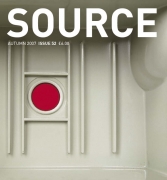The Medical Universe
Clinic - Open Eye Gallery 14th June - 1st August 2007
Review by Jesse Alexander
Issue 52 Autumn 2007
View Contents ▸
We all know the particular odour of hospitals, the uncomfortable waiting room furniture, the diffused lighting, the corridors decorated with posters reminding us to be aware of various diseases. Rémi Faucheux, art director of RVB a new commissioning institution based in Paris seeks to go beyond these clichés to define the aesthetics of the medical universe (although it should be noted that this universe does not reach much further than central Europe) where design and architecture is governed by functionality and economic factors alone.
The twelve artists selected by RVB were asked to produce work exploring the aesthetics of the medical world, mostly through residency programmes with European hospitals and other medical institutions. Exhibited here are the twelve projects on a looped DVD double projection with a soundtrack, and in the next room, a project which was completed by the editors of Useful Photography magazine, a Netherlands-based publication that examines various sorts of vernacular photographs within an art context. Ville Lenkkeri, The Month Before Birth
Ville Lenkkeri, The Month Before Birth
The first piece of work on the main projection is by Albrecht Kunkel and consists of a series of portraits made at a hospital in Lyon of pregnant women who are expecting their first child. The projection ends with Mario Palmieri's series Death Chamber which examines the mortuary space, and also how cadavers are presented to the family of the deceased. These two pieces of work provide the whole series with a narrative that reads as a journey from life to death. However, although patients and their doctors, paramedics and consultants feature throughout the different projects, it is the institutions and the different spaces in which these practices and procedures take place which feature most prominently. The photographic styles of the individual photographers are, for the most part, not all that different. Most, if not all, have worked with large format cameras and have a rather typical documentary appearance, with one or two exceptions: Geoffroy de Boismenu's series The Soul and the Machine looks at the operating field (the area of the body to be worked upon by a surgeon) which is left exposed while the rest of the patient's body is made anonymous, shrouded in sterile cloth. De Boismenu's images are much more abstract than the other pieces and theatrical, due to the way he spotlights (or perhaps exploits the operating room light in some way) the body. Peter Granser's contribution is called Alzheimer, a series of bleached-out, close-up portraits of dementia patients (appropriately the penultimate project). Here the patients' faces drop in-and-out of focus, an eloquent metaphor of their mental and physical state and a particularly successful strategy.
The decision to project the different works, one after the other, has its advantages but is, for the most part, problematic. In an interview, Rémi Faucheux is candid enough to admit the economic and logistical benefits of being able to present as many as three hundred, well-sized images in one gallery space. He also states that projecting images is a way of accentuating the individuality of each series. However, I found the reverse to be the case: the sense of scale of each project is lost, and, with the similar visual styles of the photographers so is the authorship of each work. Although the different images are thoughtfully assembled on the screen, and good use is made of the twin projectors, the details within them require more time and closer scrutiny. There is also a sense that you are looking at a series of short films rather than a collection of photographic projects. However, this does at least give an impression of Clinic existing as a completed project in its own right rather than a cluster of works by artists examining a similar theme. Christophe Bourguedieu, Scenes #6 - Courtesy Open Eye Gallery
Christophe Bourguedieu, Scenes #6 - Courtesy Open Eye Gallery
The contribution by Useful Photography, # Medical, is definitely more suited to a video projection than the other twelve projects. Images of surgical instruments, prosthetic limbs and before and after shots of plastic surgery operations are mixed with images of dated medical equipment and ambiguous procedures, all taken from hospital archives, journals and textbooks. This collection is more unsettling and a little bit macabre in comparison to the other projects, which is perhaps why a decision was made to limit the projection to a relatively small screen. One montage, of tongues with various different diseases (or samples of a disease) is particularly unsightly.
A further drawback of the video projection is that you lose the sense of the scale of this whole project, which is an injustice. Clinic is by no means a comprehensive study of the aesthetics of medicine and the fact that the project is limited geographically to central Europe is disappointing; however, that so many different artists can be commissioned to make original work exclusively for one group exhibition (with the exception of Alzheimer by Peter Granser) is certainly something to be celebrated.
Other articles by Jesse Alexander:






